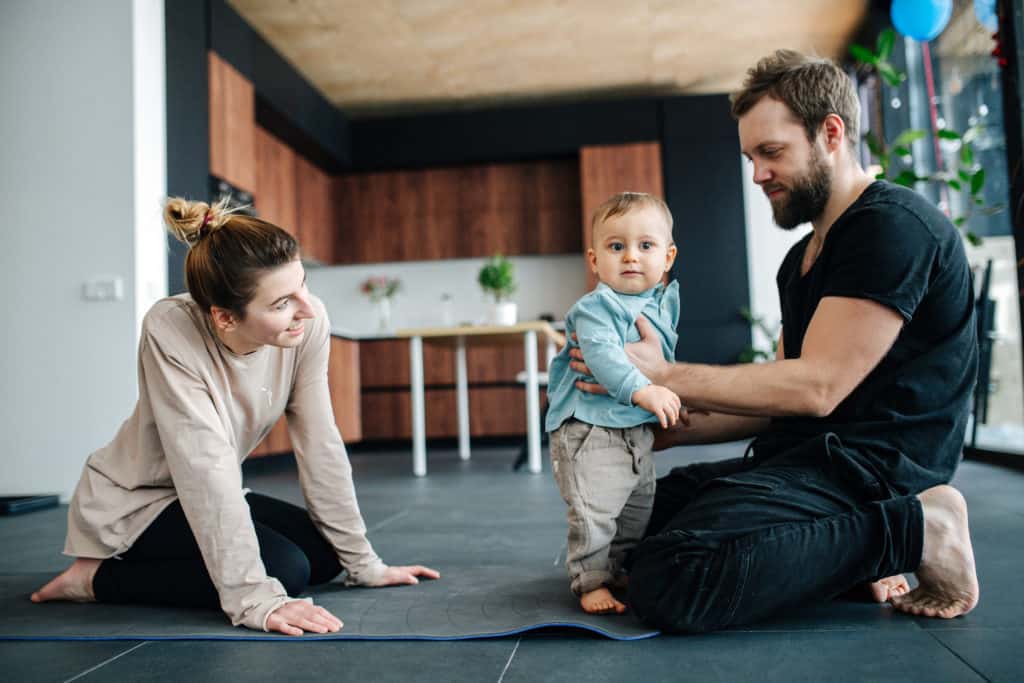This article is evidence-based, verified by John Cottrell, Ph.D. in Clinical Psychology
Caring for others is truly a selfless act. Whether you’re a parent or a caregiver of children with special needs, you set your needs aside to tend to the needs of another individual. It takes a lot of energy and certainly a lot of heart. The outpouring of giving from a parent, guardian, or caregiver is priceless.
Even though this outward expression of love is essential, it can leave a person depleted and tired. All or most of their energy is given to their loved ones for whom they care. Little, unfortunately, is retained for self-care.
For a parent or caregiver to continue devoting their time and energy to this seemingly never-ending task and duty, taking care of self is vital. Stress is a typical result of this physical and mental exertion. Yoga can be the self-care a parent needs to rejuvenate themselves so they can continue moving forward.
What is Stress?
To fully comprehend how yoga can manage stress, it is crucial to have some understanding of what stress is and how it affects the mind and body.
When you experience stress, a typical physiological response occurs that triggers the parasympathetic nervous system . Often, there is an increase in heart rate and pulse, Palms begin to sweat, pupils dilate, and a hormone called cortisol releases into the bloodstream. Cortisol is like an emergency boost of energy when the body needs to act quickly.
. Often, there is an increase in heart rate and pulse, Palms begin to sweat, pupils dilate, and a hormone called cortisol releases into the bloodstream. Cortisol is like an emergency boost of energy when the body needs to act quickly.
Even in our modern lives with technological comforts, you may need to run from a dangerous encounter or stand your ground. After the stressful event is over, these functions return to a stable state. However, you are not always in these states of imminent danger where you need to fight or flight. Too commonly now, stress is an everyday occurrence; people live in a constant state of stress and anxiety.
Many things today create stress: demanding jobs, busy schedules, lack of sleep, not getting enough exercise, and taking care of others. These actions elicit the same physiological response in the brain: an increase in heart rate and the continuous release of cortisol into the bloodstream.
This, potentially, can be hazardous to your health. With high levels of cortisol comes a decline in mental functioning, particularly in the prefrontal cortex that is responsible for learning and memory. Further, chronic stress is related to symptoms of heart disease and other illnesses like diabetes.
How Can Yoga Help with Stress?
Yoga is a reliable resource that can manage and reduce the symptoms of stress. Many are familiar with yoga being a physical exercise. True, but there are varieties of yoga practices that are quite beneficial, especially when managing stress.
One of the main components of yoga is breathing. It is the foundation of most practices; whether you are enjoying a moving exercise or sitting in meditation, breathing is the key. It is the source for bringing the body and mind to presence. It provides the practitioner with the opportunity to focus on self-care and send other responsibilities temporarily to the periphery.
Physiologically, this is what breathing does. When you take slow, deep breaths, this has a direct effect on the central nervous system. Calm breathing stimulates the hypothalamus, a primordial section of the brain, located between the thalamus and the pituitary gland.
It acts as the regulator for maintaining homeostasis, or balance, throughout the bodily system. It plays an essential role in regulating body temperature, hunger, blood pressure, sleep cycles, and more. These are crucial functions of the body that we want to maintain balance and stability.
Slow breathing causes the hypothalamus to secrete hormones that inhibit stress-inducing hormones (like cortisol) from being released. When there is less cortisol streaming through the body, the body can experience a more relaxed state. Breathing slowly also results in a reduced heart rate and lowers your blood pressure. These, too, are related to a calmer state of mind and body.
Pranayama for Stress
In yoga, there is a specific breathing practice called Pranayama. If you split the word, you get a better understanding of what it is. “Prana” is “the life force” or “life energy.” It is what gives all things life. We experience Prana with the breath. As we breathe, we are allowing the life force to flow through the entire body.
“Yama” refers to the action we give the inspiration. For example, you may breathe slowly, quickly, or with a staccato pulse. This is breath control: intention we give to the breathing effort to move Prana throughout the body. There is a multitude of Pranayama exercises that facilitate the pranic flow.
Further, it clears the energetic obstacles that inhibit the fluidity of Prana. Emotional stress, anxiety, and tension get stored up in the energy channels of your body. They need cleansing to feel relief. Breath control is a resource that begins this clearing process.
A simple Pranayama exercise that can help relieve stress is called Ujjayi (oo-JAH-yee) Pranayama. This means “Victorious Breath.” Here is how you do it.
First, sit comfortably on the floor or an upright chair. Close your eyes and begin to focus on your breath. Simply be aware that you are breathing. Take a moment to breathe deeply through your nostrils. Imagine you are smelling a beautifully scented flower. Exhale slowly through your nostrils. Do this a few times to experience the sensation of air moving through your nose. This is not quite Ujjayi Breath, but this is the first step.
Next, open your mouth wide and take a deep breath in through your mouth. Imagine you are gasping for breath in slow motion. You may even feel a coolness hit the back of your throat. Exhale through your mouth as if you are fogging a mirror. This may send warmth from your mouth. Breathe like this a few more times. Continue to notice how your throat muscles engage as you breathe in and out. You are getting close to Ujjayi Pranayama.
Lastly, close your mouth, take another deep breath in, but imagine that your mouth is still open. As you inhale, air will naturally move into your nose, but you are using the muscles of your throat to engage the in-breath. In the same fashion, exhale with your mouth closed. Air will move through your nose. This is Ujjayi Pranayama. With practice, you will notice that you can take intense breaths in and out using this technique.
With this slow, intentional breathing, you have begun the training of your parasympathetic nervous system. Your heart rate and pulse will slow down, the stress response of the prefrontal cortex is less likely to activate, and no cortisol releases into your bloodstream. These are the elements that equate to a reduction of stress.
When there is a reduction of stress, you experience a sense of clarity in your mind. Your thinking is more focused, allowing you to make more rational decisions for yourself, your family, and those with whom you work. You also regain energy throughout your body. This, of course, makes way for the continued care you offer to others, especially your children.
There will also be a mood shift. As you know, feeling stressed can bring you down. You may feel irritable, annoyed, or upset due to pent up stress. These eruptions in emotions certainly are not congruent with providing care for self or others. Having a way to dispense these feelings, healthily, is needed to continue your compassionate work. Is there a particular style of yoga that can help a parent or caregiver when these less-than-positive emotions arise?
What Type of Yoga Can a Parent or Caregiver of Children Do?

With busy schedules, it can be a challenge to find time for decent self-care. You may feel obligated to take an hour or two to give yourself the quality time needed for stress-reduction efforts. But finding large amounts of time for such tasks can be nearly impossible.
A yoga and breathing practice, however, does not necessarily need a lot of time. In reality, a few minutes each day is all you need. Here is a short moving yoga practice that only takes 3 minutes to practice. It is called the Sun Salutation and can be practiced anytime during the day. It is most effective when you do it in the morning as the very first thing you do when you get out of bed.
Sun Salutation for Stress
Technically, this is a Half Salute to the Sun. It is a short series of poses that only takes several minutes to do.
Start by standing nice and tall. Be sure your feet are well-grounded, and there is an even distribution of weight between both feet. This creates a sense of solidity and balance. Your arms can rest down by your side. Roll your shoulders slightly back to instill good posture in your upper body.
Close your eyes and take a few moments to focus on your breath. Take slow deep breaths. You can even practice Ujjayi Pranayama.
Take a full inhale and raise your arms overhead. Experience a full stretch as you fill your lungs with air. Exhale and slowly fold forward. Keep a bend in your knees to protect your back as you fold forward.
(It’s ok if you don’t touch your toes.)
Feel free to hold this position for a breath or two. It allows for a beautiful stretch and releases through your back, neck, and shoulders.
Inhale and slide your hands up to your knees or thighs until your torso is parallel to the floor. Exhale to lower your way back down toward your toes. Take another full inhale to rise, extend your arms overhead. Exhale to bring your arms down by your side. This is the Half Salute. You can repeat this 3 to 5 times.
Practicing this yoga flow first thing in the morning gets your body moving, gets fresh blood and oxygen surging through your body, warms up your muscles, releases some physical tension, and sets the positive mood you want for the remainder of your day.
As a parent or caregiver, you want to be present for the people you serve, help, and assist. Yet, before you can be fully present for those valued people in your life, it is just as imperative to give that love and care to yourself each day.

John Cottrell, Ph.D. is a yoga instructor and certified yoga therapist in Salt Lake City, Utah, USA. He has been teaching yoga since 2000. John is originally from Oakland, California earning his Master of Science and Ph.D. from Pacific Graduate School of Psychology in Palo Alto, California. His clinical practice led him to child and adolescent psychotherapy, drug and alcohol treatment, psychological and neuropsychological testing, and group/couples therapy. John continues his devotion to sharing health and well being through his business, mbody, from which he offers private and group yoga classes, yoga therapy, workshops, retreats, written yoga articles, and a men’s yoga clothing line.
References
- https://www.tuw.edu/health/how-stress-affects-the-brain/

- https://www.forbes.com/sites/daviddisalvo/2017/11/29/how-breathing-calms-your-brain-and-other-science-based-benefits-of-controlled-breathing/#7d4aee022221

- https://healthfully.com/why-does-deep-breathing-calm-you-down-4922207.html

- https://www.mindful.org/how-the-brain-changes-when-you-meditate/

- https://www.ekhartyoga.com/articles/practice/what-is-pranayama

- https://www.yogajournal.com/practice/ray-of-light

